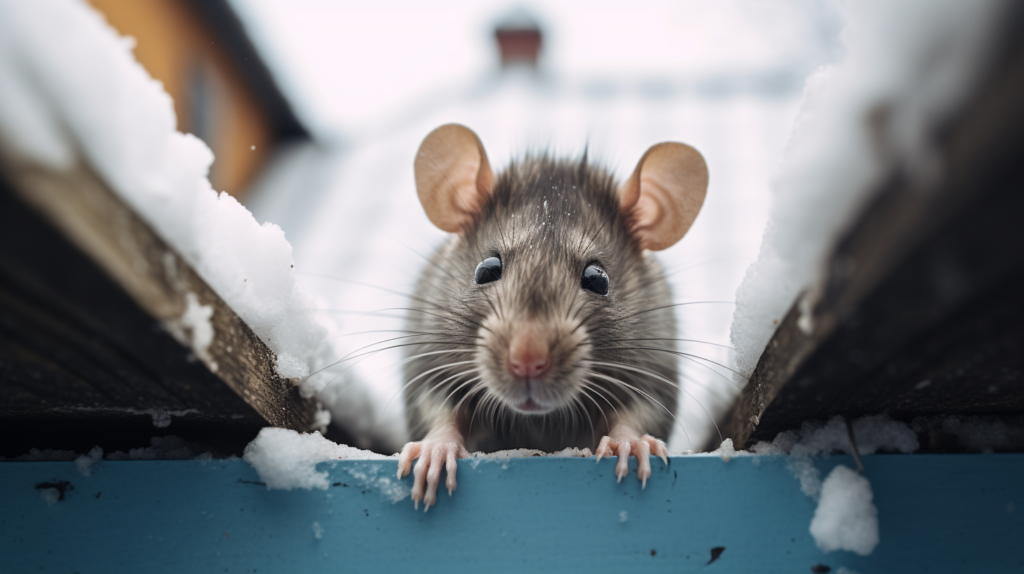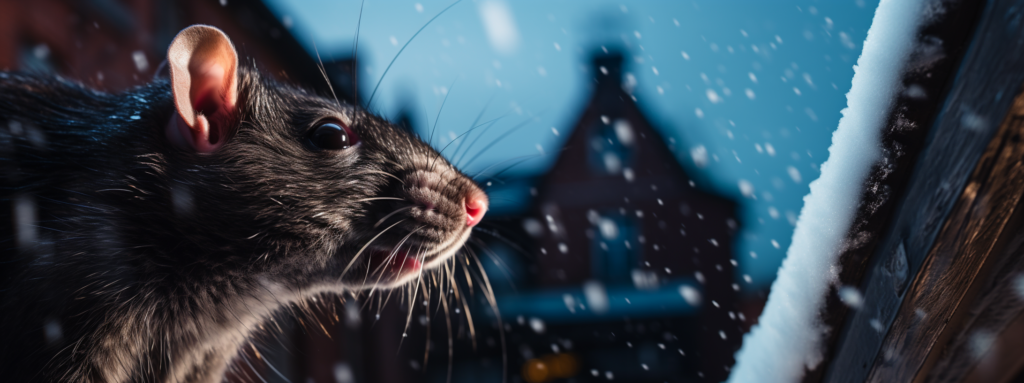When Temperatures Drop: A Guide to Identifying Rodent Invasions
Arming Yourself With Information
In the face of dropping temperatures, Ohio homeowners are presented with a unique challenge: the increased likelihood of rodent invasions and the need for rodent removal services when they create an infestation. As the seasons transition from fall to winter, mice and rats, driven by their instinctual need for warmth, become more inclined to find refuge within our homes. From understanding the signs, such as gnawed wires and distinctive noises, to answering pressing questions about rodent survival tactics in cold weather, you will learn this and more in this comprehensive guide to preparing for and managing rodent challenges during the fall and winter seasons.
Key Takeaways
- Rodents are more active in the fall as they search for food and shelter.
- In winter, rodents become more cautious and seek warmth and protection indoors.
- Understanding these behavioral shifts helps in preventing and managing rodent invasions.
- Effective pest management requires knowledge of rodent behavior in cold seasons.
Understanding Rodent Behavior in Cold Seasons
Understanding rodent behavior in cold seasons is crucial for effective pest management. In the fall, rodents tend to be more active as they search for food and shelter to prepare for winter. However, their behavior undergoes significant changes in winter, as they become more cautious and seek warmth and protection indoors. By understanding these patterns and behavioral shifts, homeowners and pest control professionals can implement targeted strategies to prevent and manage rodent invasions during the colder months.
Rodent Activity Patterns in Fall
In the fall, rodents exhibit distinct activity patterns as they adapt to the challenges of the cold season. Understanding these patterns can help in managing rodent populations effectively. During this time, rodents tend to increase their activities in search of food and shelter. They are driven by the need to stock up on resources for the upcoming winter months. This is also the time when rodent population growth tends to peak as they take advantage of the abundance of food and favorable weather conditions. However, as winter approaches, rodents start to prepare for hibernation. They become less active and seek out warm and secure places to nest. Understanding these activity patterns is crucial in implementing preventive measures and controlling rodent infestations during the fall and winter seasons.
Behavioral Changes in Winter
Rodent behavior in cold seasons undergoes significant changes, particularly in their search for warm and secure nesting places. As temperatures drop, rodents seek shelter indoors, often invading homes and buildings. Understanding their behavioral changes during winter is crucial for effective pest management.
One important survival strategy for rodents in winter is hibernation. While many rodents do not hibernate in the traditional sense, they do enter into a state of torpor, reducing their activity and metabolic rate to conserve energy. This allows them to survive in harsh conditions with limited food resources.
To emphasize the impact of behavioral changes in winter, consider the following table:
| Winter Behavior Changes | Implications |
|---|---|
| Increased Nesting Activity | Rodents are more likely to seek shelter indoors, leading to an increased risk of infestations. |
| Reduced Foraging | With limited food sources available, rodents may become more aggressive in their search for sustenance, leading to increased damage and contamination. |
| Increased Gnawing | Rodents may chew on electrical wires, insulation, and other materials to sharpen their teeth and gain access to food and nesting sites. |
| Decreased Reproduction | Due to the scarcity of resources, rodents may exhibit reduced breeding activity, which can temporarily slow population growth. |
| Increased Vulnerability to Predators | Cold temperatures and reduced activity make rodents more susceptible to predation by natural predators. |
Recognizing Signs of Rodent Infestations

Recognizing signs of rodent infestations is crucial in order to address the problem promptly. Visual clues in your home, such as gnawed wires or holes in walls, can indicate the presence of rodents. Additionally, noise indicators, such as scratching or scurrying sounds, may suggest an infestation. Lastly, analyzing rodent droppings can provide valuable information about the type and extent of the infestation. By being aware of these signs, you can take appropriate measures to address the issue and prevent further damage.
Visual Clues in Your Home
Identifying the visual clues of a rodent infestation in your home requires keen observation and attention to detail. Conducting a thorough visual inspection is crucial in detecting the presence of these unwanted pests. Here are three key signs to look out for:
- Droppings: Rodents leave behind fecal pellets that resemble small grains of rice. Finding these droppings in areas such as cabinets, drawers, or along baseboards is a clear indication of an infestation.
- Gnaw marks: Rodents have a constant need to chew to keep their teeth from growing too long. Look for gnaw marks on furniture, walls, and electrical wires. Fresh gnaw marks indicate an active infestation.
- Grease marks: As rodents travel along walls and baseboards, they leave behind smudges and grease marks from their fur. These dark, dirty streaks can be a sign of their presence.
Noise Indicators of Rodents
One key way to detect signs of rodent infestations in your home is through the sounds they make. Audible evidence of rodent presence can help homeowners identify the problem early on and take necessary measures to control the infestation. Rodents, such as mice and rats, are known for their scurrying and scratching noises, especially during the night when they are most active. These sounds can be heard in walls, ceilings, and attics. Sound-based methods for rodent detection include placing your ear against walls or floors to listen for faint scratching or gnawing sounds. Additionally, setting up audio recording devices in areas suspected of rodent activity can help capture and analyze the sounds for further confirmation. By paying attention to these noise indicators, homeowners can promptly address rodent infestations and prevent potential damage to their property.
Analyzing Rodent Droppings
To further investigate signs of rodent infestations, an important aspect to consider is analyzing the presence of rodent droppings. Rodent droppings can provide valuable information about the extent and severity of an infestation. By examining the size, shape, and color of the droppings, you can determine the type of rodent present, whether it be mice, rats, or squirrels. Additionally, analyzing the freshness of the droppings can give you an idea of how active the infestation is. It is important to note that rodent droppings can pose health risks, as they can carry harmful bacteria and viruses. Therefore, it is crucial to handle droppings with caution, wearing gloves and using appropriate cleaning methods to minimize the risk of contamination. Regular analysis of rodent droppings can help you stay proactive in preventing and controlling infestations, ensuring the safety and well-being of your home or business.
Frequently Asked Questions

How Do Rodents Survive in Cold Weather Without Freezing to Death?
Rodents survive cold weather through various adaptations and behaviors. They may hibernate, lowering their body temperature and metabolic rate. They also create nests and burrows, providing insulation and protection from freezing temperatures.
What Are the Most Common Entry Points for Rodents in Homes During the Fall and Winter?
Common rodent entry points in homes during fall and winter include gaps in windows, doors, and foundations. Signs of infestation may include droppings, chewed wires, and nesting materials. Prompt identification and sealing of entry points are crucial for prevention.
Are There Any Specific Rodent Species That Are More Active During the Fall and Winter?
Certain rodent species exhibit increased activity during the fall and winter seasons. Understanding the behavior and activity patterns of rodents during colder months is crucial for effective pest control and prevention measures.
Can Rodents Cause Any Health Risks During the Colder Seasons?
Rodents can indeed pose health risks during colder seasons. They can transmit diseases such as hantavirus and leptospirosis through their urine and droppings. Proper prevention and control measures are crucial to minimize these risks.
What Are Some Effective Preventive Measures to Keep Rodents Out of Homes During the Fall and Winter?
Preventive measures are essential to avoid rodent infestation in homes during fall and winter. Effective strategies include sealing entry points, keeping food sources secure, regular cleaning and decluttering, and utilizing traps or professional extermination services if necessary.

